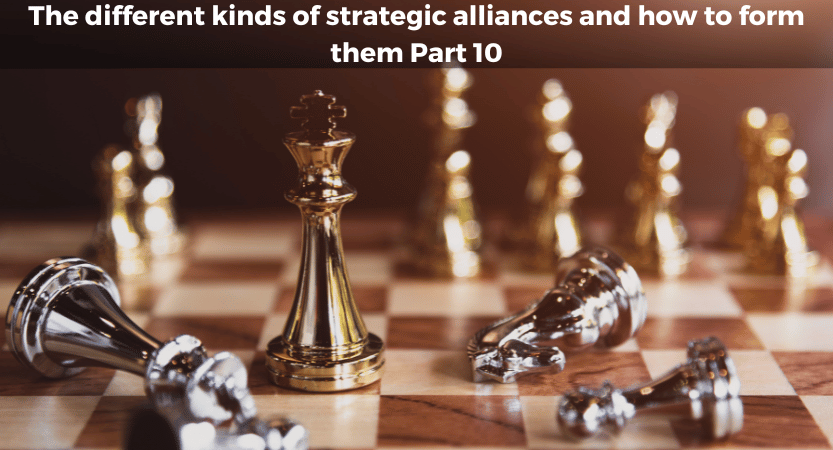Strategic Alliances Types
According to two criteria—the degree of organisational interaction and the likelihood of conflict amongst alliance partners—the strategists Yoshino and Rangan have categorised the strategic alliance. The strategists attempt to clarify two points to the alliance partners with this classification:
i. The degree of interaction required between the partners for the alliance to function well.
ii. Recognise the possibility of conflict from having rivals in the same market.
These led to the emergence of four categories of strategic alliances:
Pro-competitive Partnerships
The limited interaction and low conflict are characteristics of the pro-competitive partnership. These kinds of alliances provide vertical integration advantages.
Take a relationship between a manufacturer and its distributors or suppliers, where the companies do not invest in the manufacturing company or distribute the semi-finished or final items.
non-rivalry alliances
These kinds of alliances have a lot of interaction and little disagreement. Companies in the same business but do not view one another as competitors create noncompetitive partnerships.
Because of the differences and contradictions of their commercial practices, a sense of competition does not arise. Companies in the industry that have geographically grown frequently form noncompetitive alliances.
Rivalry Partnerships
As their name implies, these partnerships exhibit high levels of engagement and conflict. Here, two competitive businesses that view one another as competitors combine to create an alliance.
Consequently, the two must engage in an intense connection with one another. These partnerships might be between or within industries. International businesses in India frequently create competitive alliances with local rival companies for specialised objectives.
Anti-competitive Coalition
A precompetitive partnership is defined by significant conflict and little interaction. A collaboration of this kind unites two companies from disparate, frequently unconnected industries to engage on a particular project, including developing new technology or products or raising awareness among prospective consumers about their applications.
Ad campaigns and cooperative R&D projects are two instances of pre-competitive alliances.
Strategies for Forming Joint Ventures, Equity Strategic Alliances, and Non-Equity Strategic Alliances
Partnerships (PV)
In a joint venture, two businesses join forces through a legally enforceable contract to create a third unique legal business entity, or “child” company. Companies start a joint venture (JV) by having all relevant parties sign a contract. Each partner shares in the venture’s gain and loss.
Joint ventures are typically established with specific goals and aren’t always meant to last as a long-term collaboration.
A joint venture creates a distinct business known as a child company by two parent companies. In a joint venture, the two parent companies maintain their autonomous operations apart from their offspring company, unlike in a merger.
Every alliance member holds a share of the offspring business. This could be a majority-owned venture (where one corporation owns more of the new business than the other) or a 50:50 partnership, depending on the terms of the agreement.
For instance, a joint venture between a chain of restaurants and a beer producer could result in a brewery opening. The restaurant chain gives experience in the hospitality sector, and the beer company supplies the brewing know-how.
Strategic alliances for equity
When two businesses form a strategic alliance, one shares equity with the other, and two companies buy the equity and shares of one another. Partial acquisition is another term for such a deal. Every participating organisation that believes in equity in the other’s company through a cross-equity transaction also forms an equity strategic alliance.
An equity strategic alliance is formed when one business buys shares in another. When two companies can benefit from each other’s core skills, they often include this kind of strategic collaboration.
For example, an energy business that specialises in lithium batteries and an auto manufacturer that wants to enhance its production of electric vehicles could form an equity strategic partnership. The relationship gives the electric car firm direct access to the manufacturing process. It allows it to influence pricing and decision-making while enabling the energy company to enhance its production output.
Alliances stratégiques sans equity
An agreement between two or more businesses to combine resources and skills results in a non-equity strategic alliance.
Neither shared equity nor child entities exist. Non-equity strategic collaborations are among the most popular because of this. It is typically more casual and flexible than a conventional partnership and equity arrangement.
When two businesses agree to a contract as strategic partners, this is a non-equity strategic alliance. Without directly investing money in one another, the two firms collaborate and share fundamental competencies under a contract.
One popular form of non-equity strategic partnership is licencing agreements, in which one business pays another business a fee to use its technology.

Author of the Article above





